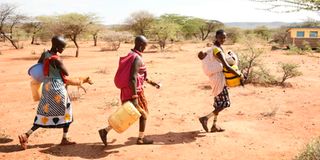Households fear drought may wipe out animals

Baringo, Kwale, Laikipia, Kitui, West Pokot and Lamu are among counties at risk of severe food shortages.
The drought ravaging arid and semi-arid parts of the country now threatens to wipe out livestock.
Samburu, Isiolo, Turkana, Mandera and Marsabit are among the seven counties ravaged by the drought.
The National Drought Management Authority (NDMA) says livestock prices continue to fall as markets also close.
“Animals have become thin, affecting their prices,” Samburu County NDMA coordinator, Alex Leseketet, told the Daily Nation.
At many livestock markets, including Maralal, Lekurru and Lolnkulian, the few animals around are emaciated.
A bull, initially going for ShSh50,000, now fetches between Sh20,000 and Sh25,000.
“I appeal to the national and county governments to help Samburu residents. We could lose people and many animals if the situation is not addressed now,” Mr Peter Loosenge, a livestock owner in Maralal, told the Daily Nation yesterday.
Mr Loosenge added that grass has dried up following the drought that began last year.
He said many families have lost animals to the drought.
Samburu County Special Programmes Chief Officer, Daniel Lesaigor, said more than 150,000 people are in need of water and relief food.
Mr Lesaigor said many children have abandoned school as families migrate in search of pasture and water.
Mr Elias Lewarani, a resident, said the government has not fulfilled its promise of buying animals.
Amaya triangle counties – Isiolo, Laikipia and Baringo – are looking into the possibility of a livestock offtake scheme.
The devolved governments say they will talk to the Kenya Meat Commission to buy the animals and also attempt to end conflicts between pastoralists and ranch owners.
The county governments will buy weak cattle, goats and sheep and slaughter them. The meat will then be distributed to vulnerable households.
Samburu Governor, Moses Lenolkulal, said authorities in the four counties expect to buy 5,000 to 10,000 animals in the first phase of the offtake.
“The drought is pushing pastoralists into ranches. There is also fight for the remaining resources,” the county boss said, adding that the livestock offtake plan has been a success in the past.
Baringo Governor, Stanley Kiptis said drought, the desert locust invasions and the Covid-19 pandemic have driven hundreds of thousands of people into an unprecedented crisis.





